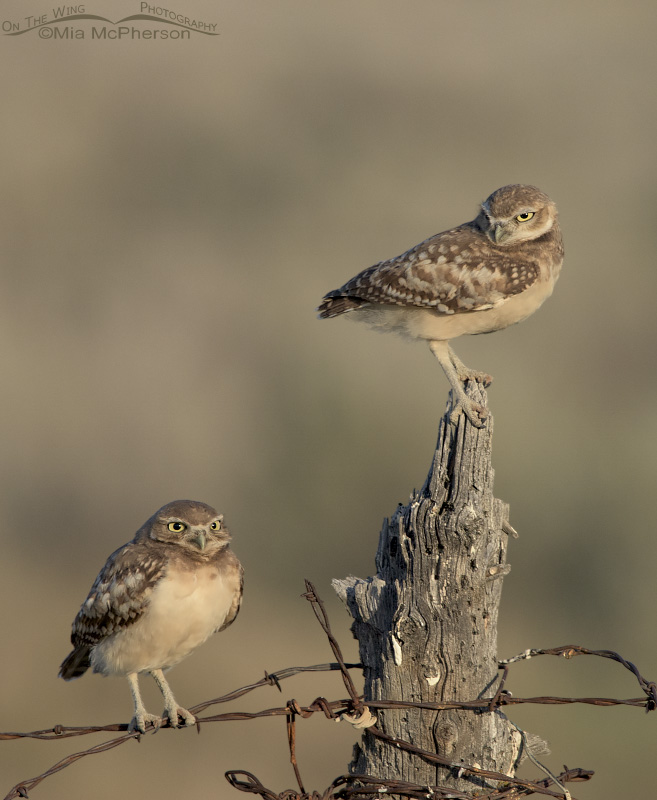 Juvenile Burrowing Owls in soft morning light – Nikon D810, f7.1, 1/1250, ISO 640, Nikkor 500mm VR with 1.4x TC, natural light, not baited
Juvenile Burrowing Owls in soft morning light – Nikon D810, f7.1, 1/1250, ISO 640, Nikkor 500mm VR with 1.4x TC, natural light, not baited
Last week I posted an image of Burrowing Owl siblings that I found in northern Utah and today I am posting images of that burrow after spending yesterday morning being delighted by them once more. This time I had much better light because I was there with them not long after the sun came up instead of much later in the morning.
Before I begin I want to state that I am always in a vehicle when photographing these owls, I never get out and I stay a respectful distance from the burrow. There is never a time when a photo is more important than the safety and well being of my subjects and if I felt my presence was disturbing the owls and their normal behavior I would simply leave. I will always put the welfare of birds or animals above the desire to get a photograph.
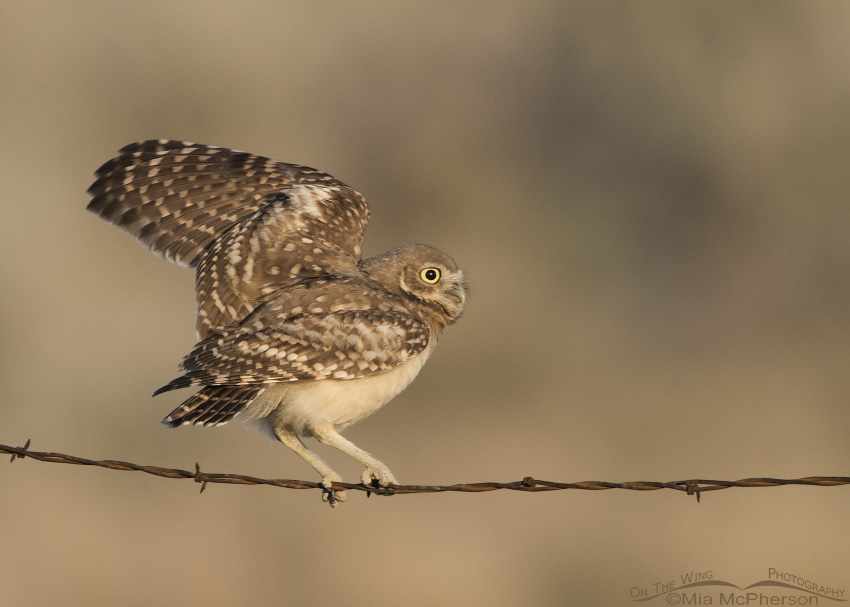 Juvenile Burrowing Owl balancing act – Nikon D810, f7.1, 1/800, ISO 500, Nikkor 500mm VR with 1.4x TC, natural light, not baited
Juvenile Burrowing Owl balancing act – Nikon D810, f7.1, 1/800, ISO 500, Nikkor 500mm VR with 1.4x TC, natural light, not baited
As far as I can tell there are at least 6 juvenile Burrowing Owls at the burrow because at one point I could visibly see six of them at once. These juvenile owls are about the size of an American Robin and are only a few weeks old, their chests will become more spotted as they age but for now their chests are a plain buffy color without markings.
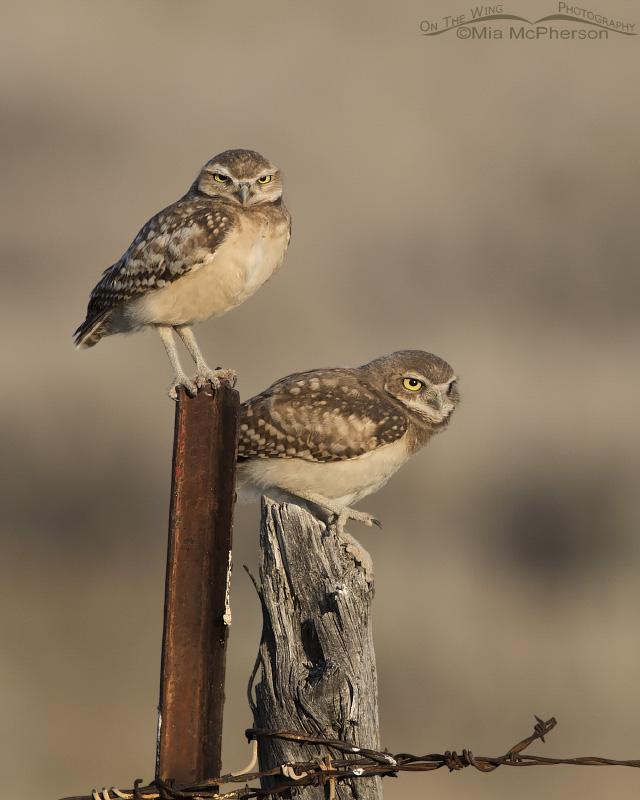 Pair of juvenile Burrowing Owls on an old fence – Nikon D810, f7.1, 1/800, ISO 500, Nikkor 500mm VR with 1.4x TC, natural light, not baited
Pair of juvenile Burrowing Owls on an old fence – Nikon D810, f7.1, 1/800, ISO 500, Nikkor 500mm VR with 1.4x TC, natural light, not baited
Burrowing Owls are often most active at dawn and dusk and will hunt during the day and night. These young Burrowing Owls are learning to hunt for themselves near the burrow now for insects and any small mammals nearby.
 Juvenile Burrowing Owl on a barbed wire fence – Nikon D810, f7.1, 1/800, ISO 400, Nikkor 500mm VR with 1.4x TC, natural light, not baited
Juvenile Burrowing Owl on a barbed wire fence – Nikon D810, f7.1, 1/800, ISO 400, Nikkor 500mm VR with 1.4x TC, natural light, not baited
They are also perfecting their balancing, landing and flight skills. This burrow has an old barbed wire fence close to it and even though the fence posts seem to be their preferred perches they do often perch on the rusty old barbed wire too.
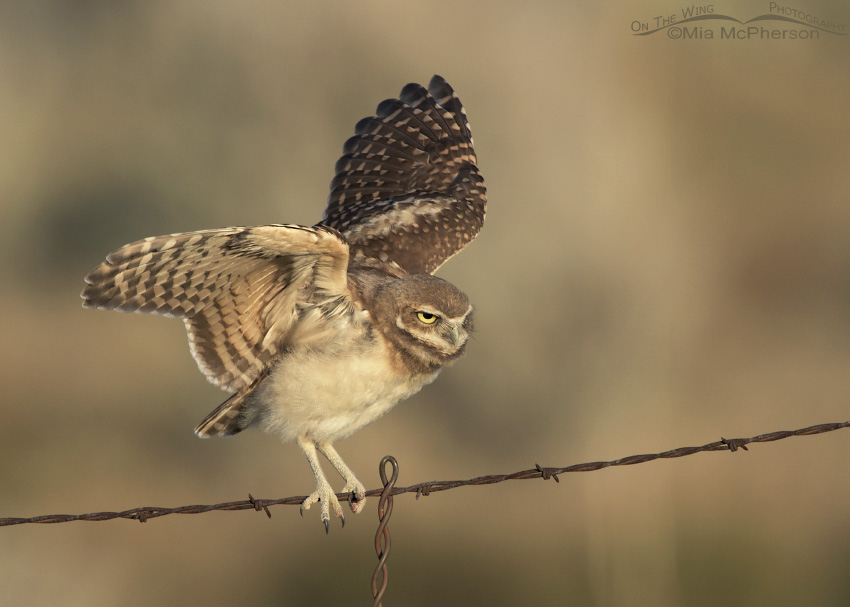 Burrowing Owl juvenile fluttering its wings – Nikon D810, f7.1, 1/800, ISO 400, Nikkor 500mm VR with 1.4x TC, natural light, not baited
Burrowing Owl juvenile fluttering its wings – Nikon D810, f7.1, 1/800, ISO 400, Nikkor 500mm VR with 1.4x TC, natural light, not baited
The barbed wire isn’t as easy to balance on so the owlets spend a bit of time getting or regaining their balance while on it.
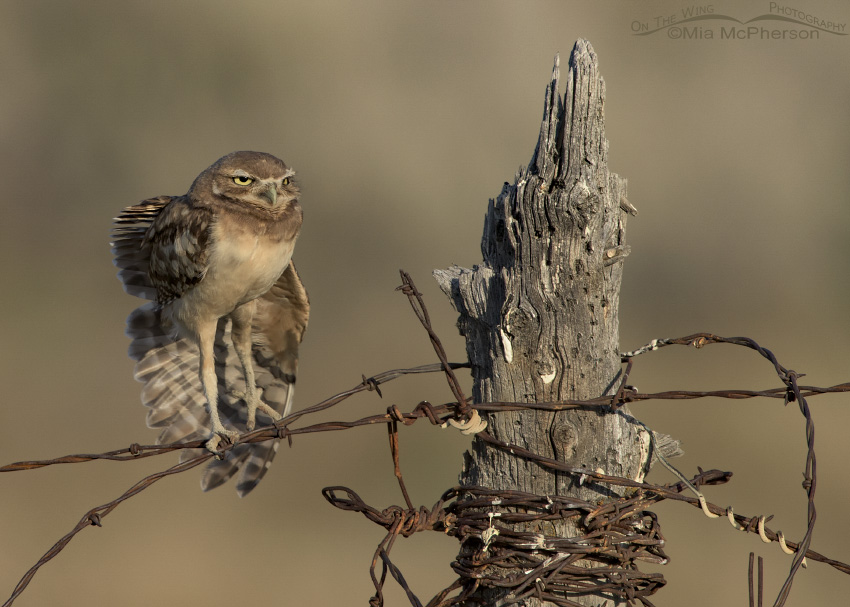 Burrowing Owl juvenile stretching its wing on an old fence – Nikon D810, f7.1, 1/1250, ISO 400, -0.3 EV, Nikkor 500mm VR with 1.4x TC, natural light, not baited
Burrowing Owl juvenile stretching its wing on an old fence – Nikon D810, f7.1, 1/1250, ISO 400, -0.3 EV, Nikkor 500mm VR with 1.4x TC, natural light, not baited
The juveniles spend a lot of time preening, stretching and looking around sometimes twisting their heads nearly upside down.
 Adult Burrowing Owl in flight – Nikon D810, f7.1, 1/1600, ISO 400, Nikkor 500mm VR with 1.4x TC, natural light, not baited
Adult Burrowing Owl in flight – Nikon D810, f7.1, 1/1600, ISO 400, Nikkor 500mm VR with 1.4x TC, natural light, not baited
The adults are usually nearby watching over their young, protecting them from predators if they come in too close as this adult was doing when…
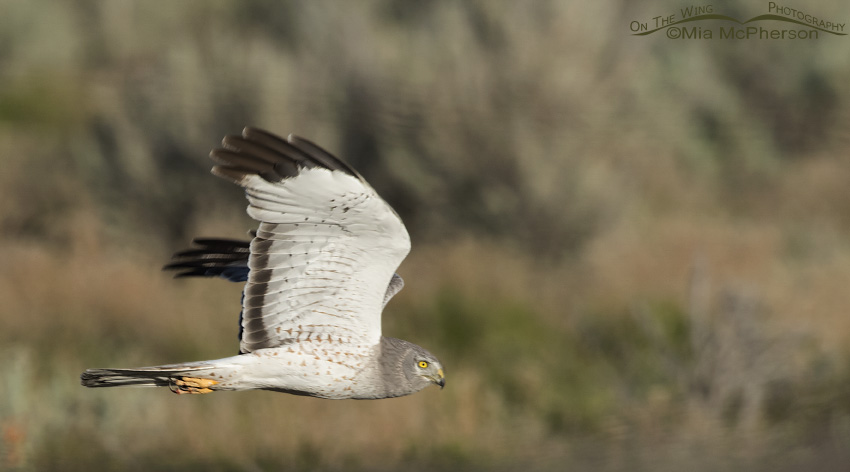 Northern Harrier male flying over a Burrowing Owl burrow – Nikon D810, f7.1, 1/1000, ISO 400, Nikkor 500mm VR with 1.4x TC, natural light, not baited
Northern Harrier male flying over a Burrowing Owl burrow – Nikon D810, f7.1, 1/1000, ISO 400, Nikkor 500mm VR with 1.4x TC, natural light, not baited
This male Northern Harrier flew in and past the burrow. The adult owl stood on the burrow near its young until it felt the danger was past. (Blurry image because I wasn’t expecting the harrier and couldn’t lock my focus on its face)
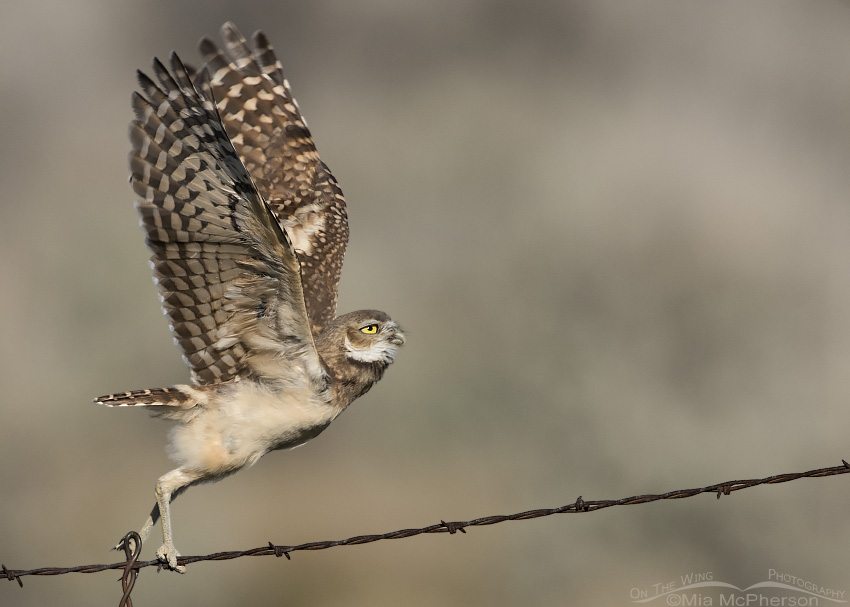 Juvenile Burrowing Owl lifting off from a barbed wire fence – Nikon D810, f7.1, 1/2000, ISO 400, Nikkor 500mm VR with 1.4x TC, natural light, not baited
Juvenile Burrowing Owl lifting off from a barbed wire fence – Nikon D810, f7.1, 1/2000, ISO 400, Nikkor 500mm VR with 1.4x TC, natural light, not baited
Once the danger was gone life went back to normal at the burrow and the young owls sat warming in the sun at the burrow opening or flew up to the fence or fence posts.
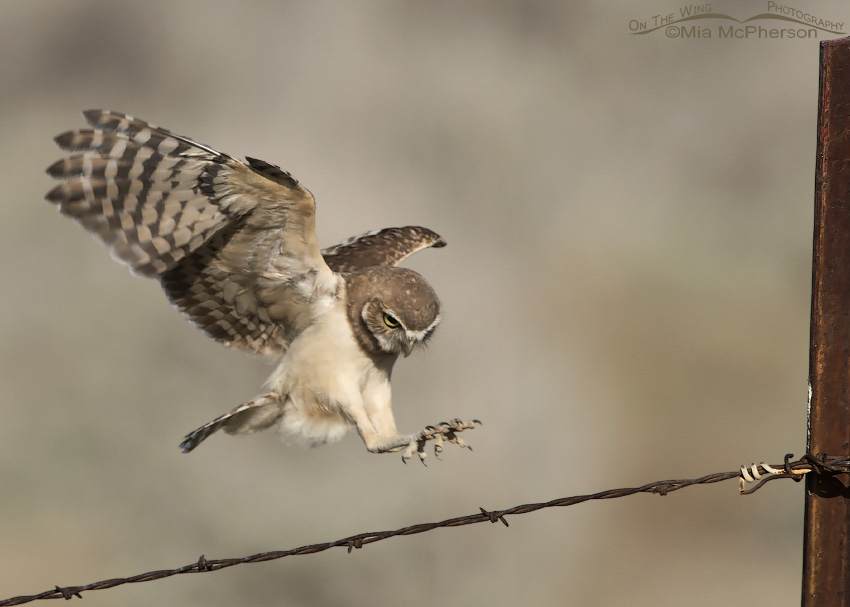 Juvenile Burrowing Owl about to land on a barbed wire fence – Nikon D810, f8, 1/1600, ISO 400, Nikkor 500mm VR with 1.4x TC, natural light, not baited
Juvenile Burrowing Owl about to land on a barbed wire fence – Nikon D810, f8, 1/1600, ISO 400, Nikkor 500mm VR with 1.4x TC, natural light, not baited
Watching them land on the barbed wire fence was interesting and I could see the look of concentration on their faces, especially immediately before their feet touched the wires.
 A juvenile Burrowing Owl immediately after landing – Nikon D810, f8, 1/1600, ISO 400, Nikkor 500mm VR with 1.4x TC, natural light, not baited
A juvenile Burrowing Owl immediately after landing – Nikon D810, f8, 1/1600, ISO 400, Nikkor 500mm VR with 1.4x TC, natural light, not baited
Then when they struggled a bit to gain or regain their balance. There was a breeze and I suspect that made a smooth landing even more challenging.
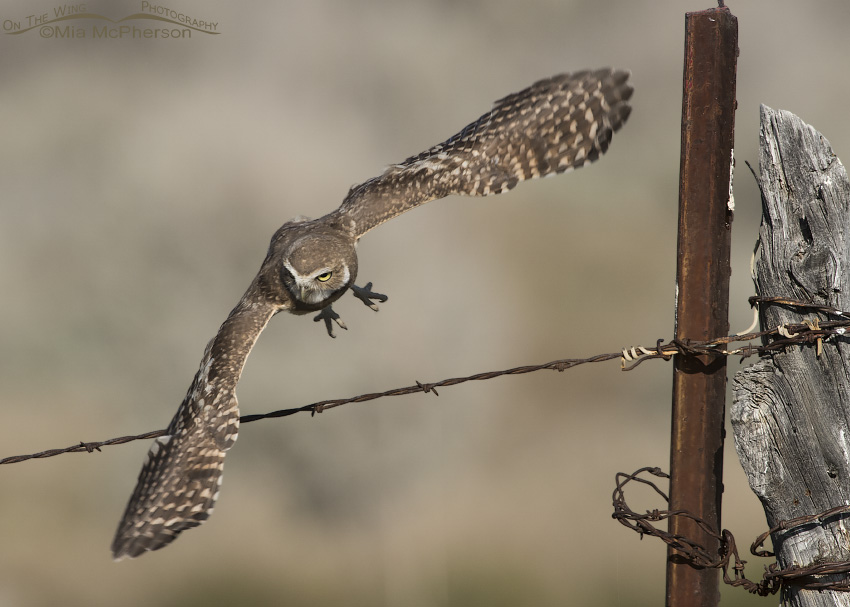 A juvenile Burrowing Owl flying towards the burrow – Nikon D810, f8, 1/1600, ISO 400, Nikkor 500mm VR with 1.4x TC, natural light, not baited
A juvenile Burrowing Owl flying towards the burrow – Nikon D810, f8, 1/1600, ISO 400, Nikkor 500mm VR with 1.4x TC, natural light, not baited
I hope that all of these Burrowing Owl juveniles do well and survive to reach adulthood. They are amazing residents of Utah’s deserts but their populations are on the decline.
Life is good. Life is even better with Burrowing Owls in my viewfinder.
Mia
Click here to see more of my Burrowing Owl photos plus facts and information about this species.
Please don’t ask for the location of this burrow, I don’t divulge nest locations, especially owl or raptor nests, unless they are well known which this burrow isn’t. I also wouldn’t announce a nest location out loud because there are unfortunately unethical people who might harass the birds by getting too close too often. I have personally seen that behavior too often.
For facts on Western Burrowing Owls take a look at these sites:
Burrowing Owl Conservation Network
Center for Biological Diversity
A great place to read about good field ethics is Principles of Birding Ethics published by the American Birding Association.


Mia, Thank you for replying. We can’t never over estimate the impact we have over the lives of others human and animals. You story is a good reminder to not allow selfish goals be more important than the respect for others.
Beautiful photos Mia. So glad you don’t reveal nesting locations.
I was a volunteer coordinator for the Burrowing Owl Project in Saskatchewan, Canada a few years back. One farmer I know, deliberately destroyed a stand of trees around a watering hole where great horned owls had nested for years – JUST – so no-one could tell him what he could and could not do on HIS land!!!
What made me even more angry was the fact that I had painted a great horned owl commission for him as a birthday present – based on those very owls.
Made me realise though how important it is not to reveal nesting sites are located. Thanks for all you do…
You have captured beauty and determination Mia! Lovely!
Very enjoyable series Mia. I am wondering – This season are you following the Burrowing Owls whose nest site was disturbed? I am interested to know if their post trauma is continuing or if they are becoming more confident again. Thanks.
Wendy, in answer to your question I have not seen burrowing owls at that burrow ever again, sadly I don’t think I ever will. Thank you
A wonderful post Mia. I also want to thank you for your time and your dedication!
Ooooooh.
Thank you, thank you, thank you.
Wonderful collection of photos and narrative. Thanks Mia.
I love this wonderful series Mia. The owls are so cute and inquisitive. I love that third photo wit the owl staring at the wire twisted around the wire.
Just fantastic! Thanks for sharing.
MIA!!! What a GREAT series of one of the funniest animals alive! I LOVE it!!! They are all such wonderful shots! I laugh out loud eveytime I look them, especially the first and sixth….they are so darned funny….THANKS!!!
Great find, Mia.
I hope you and Ron have them to yourselves for the duration. I know that when I made the Long-eareds known, I was inundated with request to come and view them. Some even got a little testy with me when I said “NO!”. For some reason it is the “Feather in the Cap” mentality of some birders that disturbs me and the birds the most. I was invited to an evening owl excursion recently and I asked if there would be any flash photography taking place and was told “absolutely not” but I declined anyway and saw the flashed owls posted the next day on Utah Birders site. I probably would have been confrontational and ruined my evening had I been there.
Thanks for your unwavering ethics. It makes your site a delight to view on a daily basis knowing who and what is the priority.
Life is Good
Good Morning Mia, Wonderful photos. I live in Arizona part of the year and am able to see Burrowing Owls often. The photos are one of your best
Len
I just love these cute owls. Awesome post and photos!
How wonderful for all of US … for a couple of reasons … we get to enjoy the antics and adorablenesssss of these guys through your lens and your expertise … and how wonderful, also, that the images themselves have been captured by a professional who is so wonderfully ethical. Thank you!!!!! You (and your feathered buddies) have certainly made my morning!!!!!!!
Wonderful series! The Borrowing Owls are disappearing in Ca. I am finding fewer and fewer of them each year.